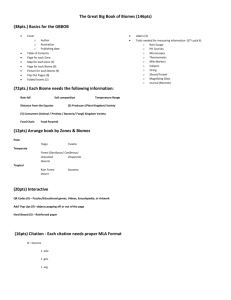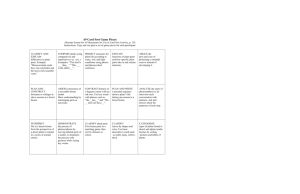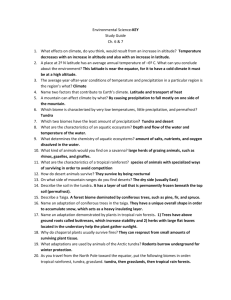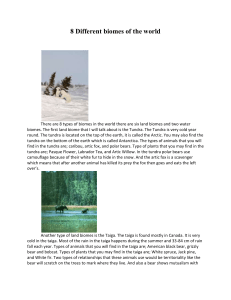OHS Environmental Science Chapters 6/7 Study Guide 1. What is
advertisement
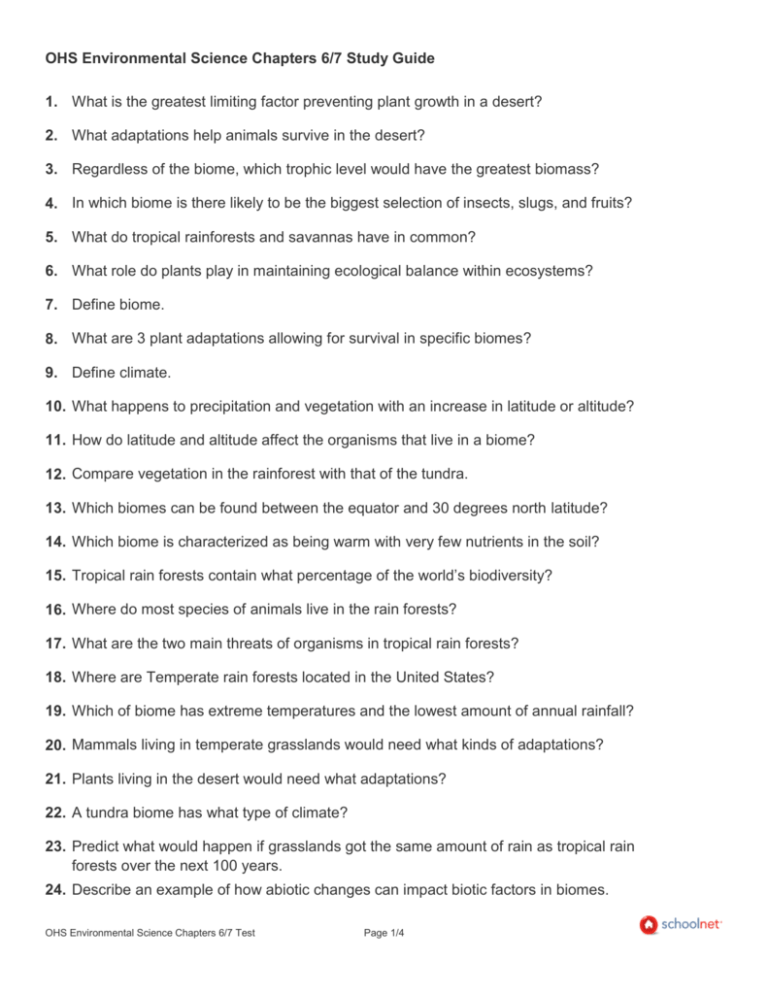
OHS Environmental Science Chapters 6/7 Study Guide 1. What is the greatest limiting factor preventing plant growth in a desert? 2. What adaptations help animals survive in the desert? 3. Regardless of the biome, which trophic level would have the greatest biomass? 4. In which biome is there likely to be the biggest selection of insects, slugs, and fruits? 5. What do tropical rainforests and savannas have in common? 6. What role do plants play in maintaining ecological balance within ecosystems? 7. Define biome. 8. What are 3 plant adaptations allowing for survival in specific biomes? 9. Define climate. 10. What happens to precipitation and vegetation with an increase in latitude or altitude? 11. How do latitude and altitude affect the organisms that live in a biome? 12. Compare vegetation in the rainforest with that of the tundra. 13. Which biomes can be found between the equator and 30 degrees north latitude? 14. Which biome is characterized as being warm with very few nutrients in the soil? 15. Tropical rain forests contain what percentage of the world’s biodiversity? 16. Where do most species of animals live in the rain forests? 17. What are the two main threats of organisms in tropical rain forests? 18. Where are Temperate rain forests located in the United States? 19. Which of biome has extreme temperatures and the lowest amount of annual rainfall? 20. Mammals living in temperate grasslands would need what kinds of adaptations? 21. Plants living in the desert would need what adaptations? 22. A tundra biome has what type of climate? 23. Predict what would happen if grasslands got the same amount of rain as tropical rain forests over the next 100 years. 24. Describe an example of how abiotic changes can impact biotic factors in biomes. OHS Environmental Science Chapters 6/7 Test Page 1/4 25. How do decomposers influence nutrient availability in topsoil? 26. The types of organisms in an aquatic ecosystem are mainly determined by ________________. 27. What are 3 factors affecting the distribution of aquatic life? 28. What two sources provide nutrients to estuaries? 29. Which of these biomes includes reefs, algae beds, and estuaries? 30. What is the source of most ocean pollution? 31. Which of the following is NOT a threat to coral reefs? 32. How do wetlands control flooding? 33. Which biome is represented by coniferous plants and migrating birds? 34. Name the biomes you would likely encounter as you move from the equator toward the North Pole. OHS Environmental Science Chapters 6/7 Test Page 2/4 KEY OHS Environmental Science Chapters 6/7 Test [24371] 1. What is the greatest limiting factor preventing plant growth in a desert? Water availability. 2. What adaptations help animals survive in the desert? they get their moisture from consuming succulent plants, are mostly nocturnal. 3. Regardless of the biome, which trophic level would have the greatest biomass? producers 4. In which biome is there likely to be the biggest selection of insects, slugs, and fruits? rainforests 5. What do tropical rainforests and savannas have in common? latitude 6. What role do plants play in maintaining ecological balance within ecosystems? Supply Oxygen 7. Define biome. A large region characterized by a specific type of climate and certain types of plants and animal communities. 8. What are 3 plant adaptations allowing for survival in specific biomes? Color, shape and size 9. Define climate. Weather conditions in an area over a long period of time. 10. What happens to precipitation and vegetation with an increase in latitude or altitude? Drier and sparse vegetation 11. How do latitude and altitude affect the organisms that live in a biome? In higher altitudes and latitudes, biomes possess less precipitation, lower temperatures, and fewer organisms that those in lower altitudes and latitudes 12. Compare vegetation in the rainforest with that of the tundra. Tall trees grow near the equator while mosses and lichens grow in the tundra. 13. Which biomes can be found between the equator and 30 degrees north latitude? Mountains, Tropical savanna, Desert, Tropical rain forest 14. Which biome is characterized as being warm with very few nutrients in the soil? Tropical rain forest 15. Tropical rain forests contain what percentage of the world’s biodiversity? 50% OHS Environmental Science Chapters 6/7 Test Page 3/4 16. Where do most species of animals live in the rain forests? canopy 17. What are the two main threats of organisms in tropical rain forests? Habitat destruction and illegal trade 18. Where are Temperate rain forests located in the United States? Pacific Northwest 19. Which of biome has extreme temperatures and the lowest amount of annual rainfall? desert 20. Mammals living in temperate grasslands would need what kinds of adaptations? Diets of flowering plants or small shrubs, great vision, and fast speed 21. Plants living in the desert would need what adaptations? A thick, fleshy stem, spiny leaves, deep roots, and a short blooming period 22. A tundra biome has what type of climate? Cold temperatures and low amounts of rainfall 23. Predict what would happen if grasslands got the same amount of rain as tropical rain forests over the next 100 years. Larger plants and trees would take over the region 24. Describe an example of how abiotic changes can impact biotic factors in biomes. Drought conditions increase competition among consumers. 25. How do decomposers influence nutrient availability in topsoil? 26. The types of organisms in an aquatic ecosystem are mainly determined by ________________. salinity 27. What are 3 factors affecting the distribution of aquatic life? Temperature, sunlight, and dissolved oxygen 28. What two sources provide nutrients to estuaries? Rivers and oceans 29. Which of these biomes includes reefs, algae beds, and estuaries? marine 30. What is the source of most ocean pollution? Activities on land 31. Which of the following is NOT a threat to coral reefs? zooplankton 32. How do wetlands control flooding? By absorbing water from rivers 33. Which biome is represented by coniferous plants and migrating birds? Taiga 34. Name the biomes you would likely encounter as you move from the equator toward the North Pole. Rain forests, deserts, taiga. OHS Environmental Science Chapters 6/7 Test Page 4/4

